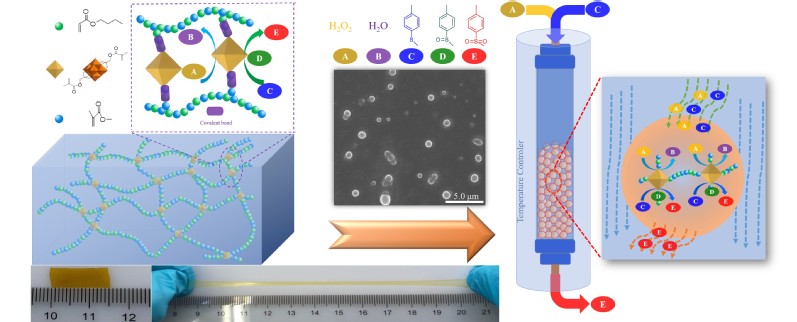Litao Ma†, Zhewei Xu†, Yidan Chen†, Mingxin Zhang†, Jiafu Yin†, Mu Li†, Kun Chen†, Panchao Yin*
The simultaneous improvements of metal oxides’ catalytic activity and recyclability are exciting, however, challenging due to the paradox for particle size requirements. Herein, we report the design of polymer nanocomposites (PNCs) by covalently integrating sub-nanoscaled meal oxide cluster (~0.7 nm) in polymer network with super elasticity. Due to the ultra-small sizes of loaded clusters and the high swelling ratios of PNCs, the swelled organo-gels from PNCs claim similar catalytic efficiencies with homogeneous catalysts while their recyclability can be simple achieved after the catalytic reactions. Thanks to their robust mechanical property, the PNCs can be processed into microgel particles for column reactors, enabling large-scale and continuous flowing catalysis.
聚合物纳米复合材料(PNCs)中聚合物与纳米颗粒(NPs)之间的协同作用改善材料性能和创造新型功能材料提供巨大的机会,并且在许多领域得到应用。PNCs体系与多种溶剂的高度相容性,PNCs 的应用扩展到了非均相催化领域,但是NPs与聚合物网络的弱的相互作用,往往导致催化活性和稳定性下降。NPs的催化性能和可回收性能的协同提升在PNCs领域引起了越来越多的关注。设计具有共价键结合到聚合物网络上的NPs的PNCs,而不影响它们与反应介质的接触和相容性是PNCs催化剂未来发展的关键。
分子簇(MCs)是一种具有明确结构和独立功能的单分散NPs,由于其超小尺寸和在结构构造和功能集成中的双重作用,被认为是设计材料概念中的“纳米原子”,为上述问题提供完美解决方案。最近,华南理工大学华南软物质科学与技术高等研究院(AISMS)殷盼超教授课题组通过共价键将亚纳米级的金属氧簇(0.7 nm)整合到聚合物网络中获得具有超弹性能的聚合物纳米复合材料(PNCs)。更重要的是,由于负载金属氧簇的超小尺寸和PNCs的高溶胀率,PNCs溶胀的有机凝胶具有与均相催化剂相似的催化效率(准均相催化),而且在催化反应后该材料可轻松回收并重复利用。此外,由于其强劲的机械性能,PNCs可以加工成用于柱反应器的微凝胶颗粒(MGPs),从而实现大规模和连续流动相催化。

文章链接:https://pubs.acs.org/doi/10.1021/acsami.0c09666

